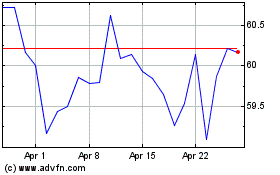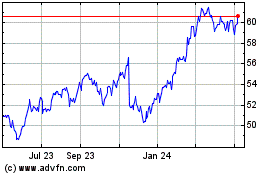Maersk Posts Record Profit, Steps Up Buyback Program -- Update
May 05 2021 - 12:50PM
Dow Jones News
By Costas Paris and Dominic Chopping
A.P. Moller-Maersk A/S said it would launch a roughly $5 billion
share-buyback program as unrelenting demand for manufactured goods
helped the Danish shipping company post a record profit for the
first quarter.
Maersk said net profit surged to $2.7 billion, up from $197
million in the first quarter of last year, boosted by big retailers
such as Walmart Inc. and Amazon.com Inc. restocking inventories
that were depleted early last year after the coronavirus pandemic
hit.
The result came in above the average forecast of $2.38 billion
of 10 analysts surveyed by FactSet.
Maersk is the world's No. 1 containership operator, moving
nearly 17% of all container capacity, according to data provider
Alphaliner, and its performance is considered a barometer of global
trade.
"It's been our best quarter ever," said Maersk CEO Soren Skou.
He said demand is driven by a race to replenish low U.S.
inventories with consumers spending Covid-19 related stimulus
checks mostly for online shopping. "That won't change anytime soon
as the American and other major economies are recovering fast," he
said.
Revenue rose 30% to $12.44 billion, in line with guidance
provided by the company last week.
Maersk said shipping volumes rose 5.7% year-over-year in the
quarter and that average freight rates were 36% higher.
The company's shares surged 6.4% on the Copenhagen Stock
Exchange to 15,945 kroner after the strong earnings report.
Maersk last month concluded the 3.3 billion kroner, equivalent
to $533.6 million, first phase of its current 10 billion kroner
share-buyback program, and plans to buy back the remaining 6.7
billion kroner between by the end of September. A new program of up
to 31 billion kroner, worth approximately $5 billion, will be
executed over two years when the current one is finalized, the
company said.
The expanded share buyback is "supported by the strong earnings
and free cash flow generation seen in both 2020 and 2021," the
company said.
Mr. Skou said he expects the boom for container ships that began
late last summer to continue until the end of the year.
"Demand from our customers for space on ships is very high up in
the third quarter. The freight rates will normalize at some point,
but we expect the current strong market to continue into the fourth
quarter," Mr. Skou said. "The pandemic continues to impact the
industry with a temporary economic upside, along with significant
operational challenges."
The cost of shipping a container from China to Los Angeles
surged to $4,140 in April from $1,579 a year earlier, and the cost
of moving one from Asia to Europe rose to $3,934 from $741,
according to the Shanghai Containerized Freight Index.
Maersk last week increased its forecast for container demand
growth to between 5% and 7% this year from a February forecast of
3% to 5%.
Mr. Skou said container ships still face long delays to unload
at congested ports around the world, including the U.S. West Coast
gateways of Los Angeles and Long Beach, and that the capacity
crunch will continue after 50 of Maersk's ships were stranded in
the Suez Canal for almost a week in March when a giant boxship,
operated by a competitor, ran aground.
Unlike many smaller carriers, Maersk has been focusing on
long-term contracts, rather than relying on spot rates. Operators
that agree to prices in the spot market can benefit from short-term
spikes, but also lose out when rates fall, often below operational
costs.
The company said it already has completed roughly 80% of its
contract deals for this year, with the remainder to be settled by
the end of this month. Long-term contract coverage will increase
20% compared with 2020, the company said.
The earnings boost will accelerate Maersk's investment into its
inland logistics business. Since 2016, when Maersk set out to
become an integrated logistics operator, the conglomerate has sold
its oil-and-tanker businesses and invested tens of millions of
dollars in warehousing and customs-clearing services globally.
Revenue from the company's logistics and services division rose
42% year-over-year in the first quarter to $2 billion.
"The benefits from the extraordinary freight market will
disappear at some point," Mr Skou said. "What is the growth we've
seen in our logistics business. Our strategy to offer inland
logistics to our ocean customers is playing out and wie are
supercharging that part of the business."
Write to Costas Paris at costas.paris@wsj.com and Dominic
Chopping at dominic.chopping@wsj.com
(END) Dow Jones Newswires
May 05, 2021 12:35 ET (16:35 GMT)
Copyright (c) 2021 Dow Jones & Company, Inc.
Walmart (NYSE:WMT)
Historical Stock Chart
From Jun 2024 to Jul 2024

Walmart (NYSE:WMT)
Historical Stock Chart
From Jul 2023 to Jul 2024
